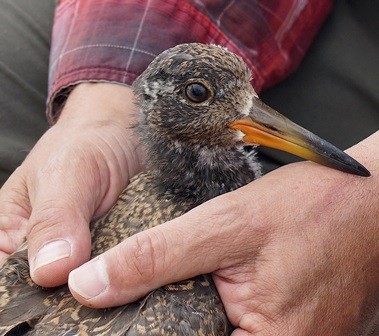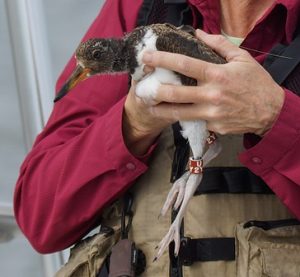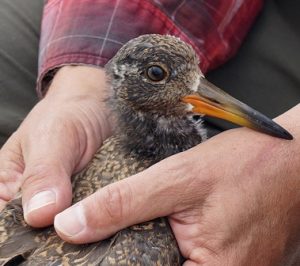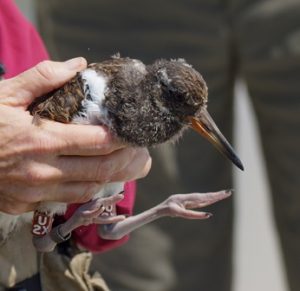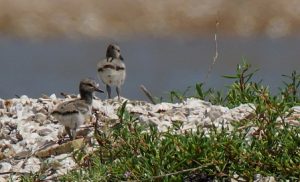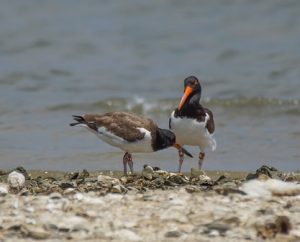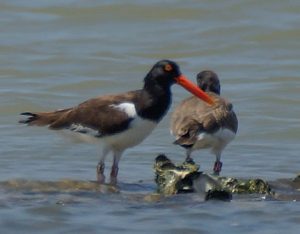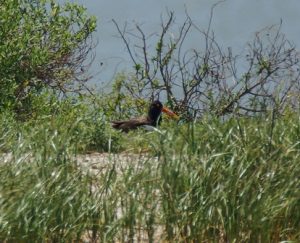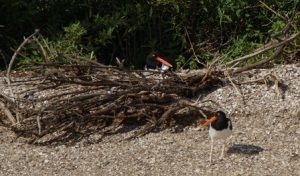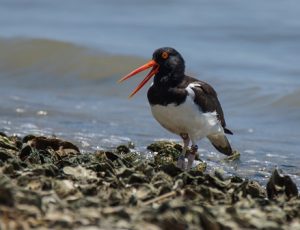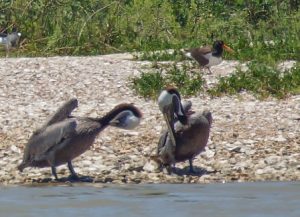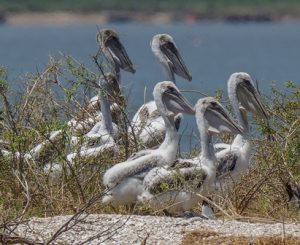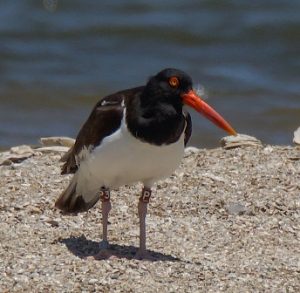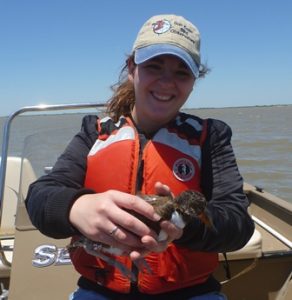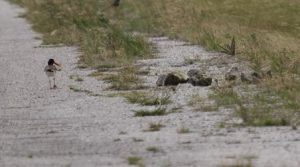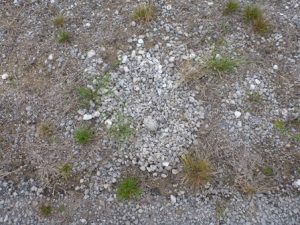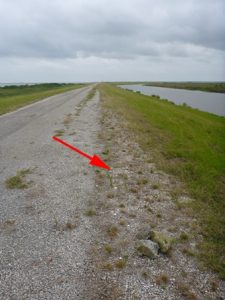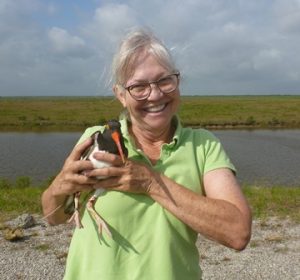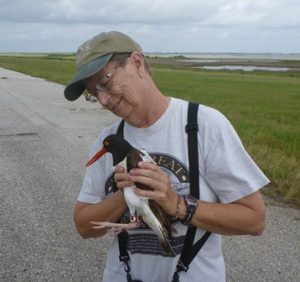By Susan Heath
On Tuesday, John Wright, Alan Wilde, and I went to check on the birds in West Galveston Bay. The wind was all over the place and we weren’t sure how much we’d be able to get done so we focused on the two chicks that needed to be banded first. Alan and I had a tough time finding the first one even though we’d watched it run along the shoreline but we finally found it laying on top of some bent over spartina about 3 feet off the shell bank. I banded it U2Y and put a nanotag on it. LL & unbanded watched from afar and were glad to have their chick back when we were done!
What a cute face! We headed up to Swan Lake to R5 & X3’s territory and found them sleeping on a reef with their chick between them. This one was a bit easier to chase down but it headed for the water and Alan made a grand swoop with the dip net and snagged it just before it got away from us. We banded this one U2X. It was a bit smaller than I thought it would be so I decided not to put a nanotag on it.
We checked on the other birds in Swan Lake and found W6 & N3 keeping some rather odd company.
I hope they steered clear of that big guy! We were delighted to find that 20 & 21’s nest had hatched and they had two chicks! We only found that nest two weeks ago but I figured it had been there a while. It was in a different place from where they usually nest and we were lucky to find it at all!
We headed back down to West Galveston Bay and found that L8 & L9 have yet another new nest, their fourth of the season. Maybe they’ll make it with this one but the Laughing Gulls are still nesting so it will be tough. We also discovered the HM & unbanded’s nest on the rock wall failed as predicted. It was probably predated by a mammal. We found JA hanging out with one of his chicks U0Y but his mate K6 and the other chick U4Y were not there. K6 was probably showing it some good foraging areas. I expect we will find this family on the nesting island less and less because these chicks are pretty old at this point.
Over on Jigsaw we saw T5 & T6 with their chick U3Y out feeding on a reef. I have been watching this pair for seven nesting seasons and this is the first time they’ve fledged a chick. I guess the Laughing Gulls gave them a break this year or they finally learned how to keep their chick safe. Very satisfying to me to see this family!
YE’s unbanded mate was sitting on a new nest.
LH & WW also had a new nest so maybe there will be some late in the season chicks here. On Gangs Bayou Island we verified that the first pair still has a chick. It will be big enough to be banded next time out. We headed back over to South Deer to check on the pairs we didn’t check on before. 13 & unbanded have a new nest in a really nice spot.
It’s up high so it won’t get overwashed. If the gulls leave them alone, they might pull off a chick. Over by North Deer and Marker 52, we found that J6 & UF’s nest had overwashed again.
JJ & P4 had a new nest in their usual spot.
The baby pelicans are still looking pretty fluffy.
H0 & JC were still incubating their nest and so were 28 & AP. Sadly, P3 and unbanded’s nest failed again (their fourth try). P3 was looking pretty disgusted if you ask me.
So despite the wacky wind we managed to do the whole survey. Thank you John for sticking with it!
On Wednesday, our GCBO summer intern Julia Moore and I joined Texas Mid-coast NWR biologist Jennifer Wilson to check out Cow Trap Lakes and Drum Bay. We went to Cow Trap Lakes first which is on the San Bernard NWR but accessed by boat from the GIWW south of the San Bernard river. Jennifer had discovered an unbanded pair of oystercatchers with a nest on the restored shell islands there. These islands support the largest nesting colony of Gull-billed Terns in the entire state but they had apparently been overwashed and abandoned the island because when Jennifer was out there last week, there were no terns or skimmers present. Well they may have not been there last week but they were back in force this week along with nearly 200 skimmers. Amazingly these birds had recolonized the island and some already had eggs in the space of one week. Wow! The oystercatchers were nesting right next to this large colony so we weren’t able to try to trap them. It was great to see that the terns and skimmers had returned to try again!
We trailered the boat and headed up to Drum Bay then to band a chick that we discovered a couple weeks ago. We left from the Swan Lake boat ramp in Surfside and were quickly up in Drum Bay where we discovered JK & unbanded and their chick doing just fine! Julia and I ran down the chick and we banded it U2W. This one was plenty big so I put a nanotag on it.
We also went to check on LE, an adult that Jennifer and I banded two weeks ago. I wanted to make sure the nanotag I put it on her was still working. Happily we found her incubating a new nest and the nanotag was doing just fine.
Although they don’t get much blog coverage, I have several very dedicated volunteers who monitor the oystercatchers nesting on the sand/shell spit off the shore of the Texas City Prairie Preserve. I’ve been frustrated that I haven’t been able to get up there and band any birds this year. I’d been hearing from them about a pair of oystercatchers that was hanging out along the paved road that runs out the levee toward Moses Lake. Weird right? Well on Wednesday Paula Kennedy emailed me that this pair had laid a nest right alongside the road! I think they must have gotten some nesting advice from a Killdeer. This is a pretty good indication of how limiting the nesting habitat is for these birds that they would pick a spot like this. Paula also told me that they had found a nest along the shoreline of Moses Lake too so I saw an opportunity to get a couple birds banded without having to find a boat. Paula and Joey Barnes agreed to meet on Friday morning and see what we could do. We were also joined by TCPP technician Abby Ficklin.
Since the nest was right alongside the road, they had placed some big rocks around it to keep it from getting run over. This is what greeted us when we approached.
The bird had just gotten up from the nest because of our approach. We waited to see if it would go back but it didn’t and eventually flew off so we went up and set up the box. Here is the nest location. Very Killdeeresk. I like the way they gathered pebbles instead of shells to make a scrape.
We left the box set up and backed off to wait. Eventually the bird came back and it didn’t take too long before it went in and was trapped. We banded it LP and I put a nanotag on it. Joey was pretty happy she got to hold an oystercatcher!
Then we went down to the Moses Lake nest. An unbanded bird was incubating so I set up the box there and that one went in and was trapped in less than five minutes! We banded that one LN and I put the last of this year’s adult nanotags on it. I sure hope we get some good data from those! There are 10 deployed now. Paula was giving LN a little love!
When we returned back down the levee, the unbanded bird was now on the roadside nest so we tried to trap it too with the box but that bird wouldn’t go in. This is usually the case. Once you get one of the pair, the other one is having nothing to do with that box!
And that is another week with the oystercatchers. I am on vacation next week in Southeast Arizona birding so the oystercatchers get a break from us until the first full week of June.
Current Stats for upper Texas coast from Dickinson Bay to East Matagorda Bay: 10 nests being incubated, 45 failed nests, 5 nests with unfledged chicks, 0 nests with undetermined status, 7 chicks fledged
This project is supported by the National Fish and Wildlife Foundation and several private donors. If you would like to contribute you can do so by clicking on the Donate Now button below. All donations are tax deductible and GREATLY appreciated.

